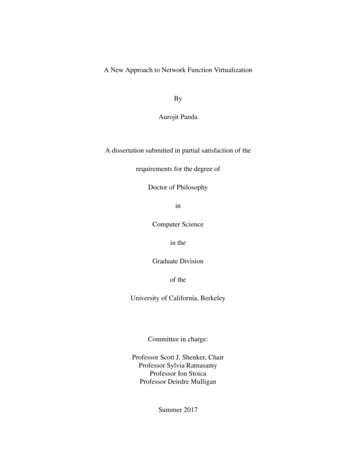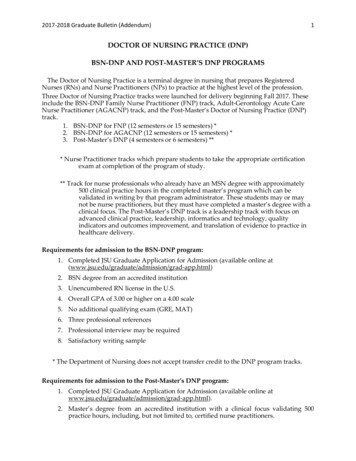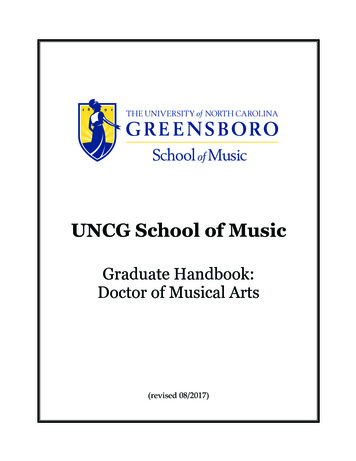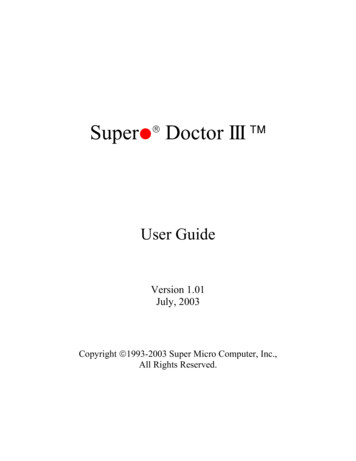
Transcription
A New Approach to Network Function VirtualizationByAurojit PandaA dissertation submitted in partial satisfaction of therequirements for the degree ofDoctor of PhilosophyinComputer Sciencein theGraduate Divisionof theUniversity of California, BerkeleyCommittee in charge:Professor Scott J. Shenker, ChairProfessor Sylvia RatnasamyProfessor Ion StoicaProfessor Deirdre MulliganSummer 2017
A New Approach to Network Function VirtualizationCopyright 2017byAurojit Panda
1AbstractA New Approach to Network Function VirtualizationbyAurojit PandaDoctor of Philosophy in Computer ScienceUniversity of California, BerkeleyProfessor Scott J. Shenker, ChairNetworks provide functionality beyond just packet routing and delivery. Network functions suchas firewalls, caches, WAN optimizers, etc. are crucial for scaling networks and in supporting newapplications. While traditionally network functions were implemented using dedicated hardwaremiddleboxes, recent efforts have resulted in them being implemented as software and deployed invirtualized environment . This move towards virtualized network function is commonly referredto as network function virtualization (NFV). While the NFV proposal has been enthusiasticallyaccepted by carriers and enterprises, actual efforts to deploy NFV have not been as successful. Inthis thesis we argue that this is because the current deployment strategy which relies on operatorsto ensure that network functions are configured to correctly implement policies, and then deploysthese network functions as virtual machines (or containers), connected by virtual switches are illsuited to NFV workload.In this dissertation we propose an alternative NFV framework based on the use of static techniques such as type checking and formal verification. Our NFV framework consists of NetBricks– a NFV runtime and programming environment, that uses type checking to provide isolation,and presents a novel dataflow based approach to writing high performance network functions; andVMN a verification tool that can automatically check whether a set of NFs correctly implementnetwork policy. Finally, we also show that simplifying NF development and deployment enablenew applications, both in the wide-area and within datacenters.
iTo my parents, friends, and teachers who made all of this worthwhile.
iiContentsList of FiguresvList of TablesviiAcknowledgmentsviii1Introduction1.1 Outline and Previously Published Work . . . . . . . . . . . . . . . . . . . . . . .142Background2.1 Runnning Network Functions . . . . . . . . . . . . . . . . . . . . . . . . . . . . .2.2 Building Network Functions . . . . . . . . . . . . . . . . . . . . . . . . . . . . .2.3 NF Chaining and Policies . . . . . . . . . . . . . . . . . . . . . . . . . . . . . . .56673NetBricks: Building and Executing Network Functions3.1 Design . . . . . . . . . . . . . . . . . . . . . . . . .3.1.1 Programming Abstractions . . . . . . . . . .3.1.2 Execution Environment . . . . . . . . . . . .3.2 Implementation . . . . . . . . . . . . . . . . . . . .3.2.1 Two Example NFs . . . . . . . . . . . . . .3.2.2 Operator Interface . . . . . . . . . . . . . .3.2.3 Implementation of Abstractions . . . . . . .3.2.4 Execution Environment . . . . . . . . . . . .3.3 Evaluation . . . . . . . . . . . . . . . . . . . . . . .3.3.1 Setup . . . . . . . . . . . . . . . . . . . . .3.3.2 Building NFs . . . . . . . . . . . . . . . . .3.3.3 Execution Environment . . . . . . . . . . . .3.4 Related Work . . . . . . . . . . . . . . . . . . . . .3.5 Conclusion . . . . . . . . . . . . . . . . . . . . . .4.91010121414161717171718212527VMN: Verifying Network Policy in the Presence of Network Functions284.1 Introduction . . . . . . . . . . . . . . . . . . . . . . . . . . . . . . . . . . . . . . 284.2 Modeling Network Functions . . . . . . . . . . . . . . . . . . . . . . . . . . . . . 30
C ONTENTS4.34.44.54.64.74.854.2.1 Network Function Models . . .4.2.2 Rationale and Implications . . .4.2.3 Real-world Examples . . . . . .Modeling Networks . . . . . . . . . . .4.3.1 Network Models . . . . . . . .4.3.2 Scaling Verification: Slicing . .4.3.3 Scaling Verification: SymmetryChecking Reachability . . . . . . . . .4.4.1 Invariants . . . . . . . . . . . .4.4.2 Decision Procedure . . . . . . .Theoretical Analysis . . . . . . . . . .4.5.1 Logical Models . . . . . . . . .4.5.2 Notation . . . . . . . . . . . .4.5.3 Reachability Invariants . . . . .4.5.4 Modeling Middleboxes . . . . .4.5.5 Modeling Networks . . . . . .4.5.6 Formal Definition of Slices . . .4.5.7 Decidability . . . . . . . . . . .Evaluation . . . . . . . . . . . . . . . .4.6.1 Real-World Evaluation . . . . .4.6.2 Data Isolation . . . . . . . . . .4.6.3 Other Network Scenarios . . . .Related Work . . . . . . . . . . . . . .Conclusion . . . . . . . . . . . . . . .iii.NSS: Open Carrier Interfaces for Deploying Network Services5.1 Idealized Scenario . . . . . . . . . . . . . . . . . . . . . . .5.2 Entities and Interfaces . . . . . . . . . . . . . . . . . . . . .5.2.1 Entities . . . . . . . . . . . . . . . . . . . . . . . .5.2.2 Tenant Interface . . . . . . . . . . . . . . . . . . .5.2.3 Client Interface . . . . . . . . . . . . . . . . . . . .5.2.4 Carrier Implementation . . . . . . . . . . . . . . . .5.3 Edge Services . . . . . . . . . . . . . . . . . . . . . . . . .5.3.1 Edge Service Requirements . . . . . . . . . . . . .5.3.2 Example Services . . . . . . . . . . . . . . . . . . .5.4 Example Usage . . . . . . . . . . . . . . . . . . . . . . . .5.4.1 Edge Based Multicast . . . . . . . . . . . . . . . .5.4.2 ICN . . . . . . . . . . . . . . . . . . . . . . . . . .5.4.3 Storage Synchronization . . . . . . . . . . . . . . .5.4.4 Edge Processing for Sensors . . . . . . . . . . . . .5.4.5 Middlebox Outsourcing . . . . . . . . . . . . . . .5.5 Discussion . . . . . . . . . . . . . . . . . . . . . . . . . . 6063636464656566666767676869697070
C ONTENTS5.667ivConclusion . . . . . . . . . . . . . . . . . . . . . . . . . . . . . . . . . . . . . . 71ucheck: Verifying Microservice Applications through NFV6.1 Applications and Inputs . . . . . . . . . . . . . . . . . . .6.1.1 Microservice Based Application . . . . . . . . . .6.1.2 Invariants . . . . . . . . . . . . . . . . . . . . . .6.1.3 Microservice Models . . . . . . . . . . . . . . . .6.2 Preventing Invariant Violations . . . . . . . . . . . . . . .6.2.1 Static Verification . . . . . . . . . . . . . . . . . .6.2.2 Runtime Enforcement . . . . . . . . . . . . . . .6.3 Debugging Violations . . . . . . . . . . . . . . . . . . . .6.4 Discussion . . . . . . . . . . . . . . . . . . . . . . . . . .6.4.1 Approximate Enforcement . . . . . . . . . . . . .6.4.2 Provable Correctness vs Enforcement . . . . . . .6.5 Related Work . . . . . . . . . . . . . . . . . . . . . . . .6.6 Conclusion . . . . . . . . . . . . . . . . . . . . . . . . .7273737475767676787979808081Future Work and Conclusion827.1 NetBricks . . . . . . . . . . . . . . . . . . . . . . . . . . . . . . . . . . . . . . . 827.2 VMN . . . . . . . . . . . . . . . . . . . . . . . . . . . . . . . . . . . . . . . . . 837.3 Conclusion . . . . . . . . . . . . . . . . . . . . . . . . . . . . . . . . . . . . . . 83
vList of Figures2.1Example NF chain for a datacenter serving web traffic. . . . . . . . . . . . . . . . . .3.1Throughput achieved by a NetBricks NF and an NF written in C using DPDK as thenumber of memory accesses in a large array grows. . . . . . . . . . . . . . . . . . . .Setup for evaluating single NF performance for VMs and containers. . . . . . . . . . .Setup for evaluating single NF performance using NetBricks. . . . . . . . . . . . . . .Throughput achieved using a single NF running under different isolation environments.Setup for evaluating the performance for a chain of NFs, isolated using VMs or Containers. . . . . . . . . . . . . . . . . . . . . . . . . . . . . . . . . . . . . . . . . . . .Setup for evaluating the performance for a chaining of NFs, running under NetBricks. .Throughput with increasing chain length when using 64B packets. In this figure NBMC represents NetBricks with multiple cores, NB-1C represents NetBricks with 1 core.99th percentile RTT for 64B packets at 80% load as a function of chain length. . . . . .Throughput for a single NF with increasing number of cycles per-packet using different isolation techniques. . . . . . . . . . . . . . . . . . . . . . . . . . . . . . . . . . y for a datacenter network with middleboxes from [121]. The topology contains firewalls (FW), load balancers (LB) and intrusion detection and prevention systems (IDPS). . . . . . . . . . . . . . . . . . . . . . . . . . . . . . . . . . . . . . .Time taken to verify each network invariant for scenarios in Chapter 4.6.1. We showtime for checking both when invariants are violated (Violated) and verified (Holds). .Time taken to verify all network invariants as a function of policy complexity forChapter 4.6.1. The plot presents minimum, maximum, 5th , 50th and 95th percentiletime for each. . . . . . . . . . . . . . . . . . . . . . . . . . . . . . . . . . . . . . .Time taken to verify each data isolation invariant. The shaded region represents the5th –95th percentile time. . . . . . . . . . . . . . . . . . . . . . . . . . . . . . . . .Time taken to verify all data isolation invariants in the network described in Chapter 4.6.2. . . . . . . . . . . . . . . . . . . . . . . . . . . . . . . . . . . . . . . . . .Topology for enterprise network used in Chapter 4.6.3, containing a firewall (FW) anda gateway (GW). . . . . . . . . . . . . . . . . . . . . . . . . . . . . . . . . . . . .7192121212323232425. 52. 52. 52. 52. 52. 54
L IST OF F IGURES4.74.84.96.1viDistribution of verification time for each invariant in an enterprise network (Chapter 4.6.3) with network size. The left of the vertical line shows time taken to verify aslice, which is independent of network size, the right shows time taken when slices arenot used. . . . . . . . . . . . . . . . . . . . . . . . . . . . . . . . . . . . . . . . . . . 55Average verification time for each invariant in a multi-tenant datacenter (Chapter 4.6.3)as a function of number of tenants. Each tenant has 10 end hosts. The left of thevertical line shows time taken to verify a slice, which is independent of the number oftenants. . . . . . . . . . . . . . . . . . . . . . . . . . . . . . . . . . . . . . . . . . . 55(a) shows the pipeline at each peering point for an ISP; (b) distribution of time toverify each invariant given this pipeline when the ISP peers with other networks at 5locations; (c) average time to verify each invariant when the ISP has 75 subnets. Inboth cases, to the left of the black line we show time to verify on a slice (which isindependent of network size) and vary sizes to the right. . . . . . . . . . . . . . . . . . 56We use a web forum as a running example throughout this paper. The webforumis comprised of three microservices: a key-value store (kv-store), an authenticationservice, and a frontend webservice. The frontend webservice receives HTTP request(indicated by the http: prefix) and makes RPC calls to the key-value store (kv-store)and authentication service. In this figure we specify the local state and RPC endpointsfor each microservice. The web forum is correct if two invariants hold: (a) postedmessages are never modified or deleted, and (b) only authenticated users can postmessages. All microservices interact by seending messages, which must pass througha virtal switch. ucheck’s enforcement mechanism is implemented in the vswitch. . . 74
viiList of Tables3.13.3Throughputs for NFs implemented using NetBricks as compared to baseline from theliterature. . . . . . . . . . . . . . . . . . . . . . . . . . . . . . . . . . . . . . . . . . 20Throughputs for the NetBricks implementation of Maglev (NetBricks) when comparedto the reported throughput in [35] (Reported) in millions of packets per second (MPPS). 21A comparison with other NFV frameworks. . . . . . . . . . . . . . . . . . . . . . . . 264.1Logical symbols and their interpretation. . . . . . . . . . . . . . . . . . . . . . . . . . 463.2
viiiAcknowledgmentsI look back upon the last six years fondly: while there were many challenges and several baddays, I found great friends, a beloved and wise advisor, great teachers, and got to meet and interactwith a community of people who have celebrated my victories and helped me persevere throughthe bad days. While this dissertation—out of necessity—lists only my name, it would not haveexisted without these amazing people, many of whom I list below:Scott Shenker: Scott has deeply influenced (in increasing order of importance) this dissertation,my time at Berkeley, and large parts of my philosophy on life. I arrived at Berkeley knowing nothing about networking, and over the last five-and-three-quarters of a year (yes I counted) Scott hasbeen a fount of knowledge about such diverse topics as networking, distributed systems, queuingtheory, the West Wing (Aaron Sorkin’s masterpiece), etc. However, beyond being knowledgeable,Scott has also been a source of wisdom about things that are both related to work (what questionsare interesting, how to phrase problems, how to write) and outside of work. In the past years Scotthas been unwaveringly positive about my work, much more so that I have been, and while thisreally annoyed me at times (since I was not sure it helped) I am now immensely grateful that hedid. Furthermore, during the last year when I was interviewing, Scott IMed me both before andafter every interview and checking to make sure things were going well. I don’t know if otheradvisors do this, but I am so very glad that mine did – thanks Scott!! Though Scott is not perfect –he seems to really dislike the Seahawks – I hope that some day I am as wise as he is, and as goodan advisor to someone as he has been to me. It is my sincere hope that the end of graduate schooldoes not mean the end of having Scott as an advisor, and I plan to continue to rely on Scott’s advicein getting through life and academia.Mooly Sagiv: Mooly, who I met relatively late in my graduate career, has been like a secondadvisor to me. Despite living in a different time zone (in Israel which 10 or 11 hours ahead),having his own students, and collaborating with several other people Mooly has tirelessly agreedto meet with me (over Skype) and even visit Berkeley during the past years. I have no formaltraining in formal methods, and have mostly stumbled through this deeply mathematical area andI would be much poorer in terms of what I know were it not for Mooly. Over the last years Moolyhas visited Berkeley on several occasions (today was one of those occasions), and I am alwaysexcited for these visits: we somehow manage to explore several 10s of topics, and while tired, I amleft with ideas which I didn’t know existed. I hope Mooly keeps visiting wherever the next yearstake me, and the discussions stay as exciting as they have thus far.Ion Stoica: I would not have done systems were it not for Ion. I met Ion during Berkeley’s visit
ACKNOWLEDGMENTSixday, and somehow as a result of this one meeting I ended up sitting in the AMPLab, and meetingall the other people who are on this dissertation. However, Ion’s contributions to my life extend farbeyond this introduction: Ion taught me how to do systems research, staying late for several daysin a row helping me figure out what to build, evaluate and write. Furthermore, he also taught mehow to react to reviews: not with anger at the reviewers, but with a desire to improve papers. Ionhas been a mentor and collaborator throughout my time at Berkeley, and the realization that Ionsometimes trusts my judgment about systems is one of the greatest rewards I have received in mytime at Berkeley.Sylvia Ratnasamy: Sylvia was a part of the NetSys Lab since I joined. I however did not startactively collaborating with her until 2014 (my third year in graduate school), this delay was myloss. Not only was Sylvia was largely responsible for introducing me to network functions (thesubject of this thesis), but beyond that Sylvia taught me how to evaluate systems (something I havenever been good at), and has tirelessly sat through talks helping improve both my delivery and thetalk’s focus.Brighten Godfrey, Michael Schapira, and Katerina Argyraki: Brighten, Michael and Katerinahave been mentors and close collaborators throughout my time in graduate school. Brighten andMichael were collaborators on my first paper [87], and helped me figure out how to write aboutalgorithms, and how to analyze their behavior. I have always strive to work on similar topics asthey do, and am deeply grateful that they take the time to visit and talk to me, even when we arenot actively working on a project. Katerina, who I collaborated with on network verification [110,108], taught me tenacity—helping rewrite no fewer than five version of one paper, each better thanthe last.Colin Scott: Colin has been a close friend, an office mate, a debate partner and a frequent collaborator throughout graduate school. A Ph.D. was once connected with understanding somethingphilosophical, if this standard were to be applied today I would fail were it not for Colin. Beyondthat Colin also did more mundane things like get Ethiopian food, and other dinners with me, forma somewhat disorganized prelim reading group, and influence more than a quarter of the papersI have worked on. Colin graduated a year earlier than I did, and has been in India since, I havesorely missed having him around.Shivaram Venkatraman: Shivaram has been a close friend, a partner in getting lunch on Saturdays, in discovering new places and cuisines, and a teacher. Shivaram taught me all the Latextricks that I now use, without ever asking for anything in return. Most importantly, Shivaram iswho I turn to when I am stuck, for he has always given me honest (sometimes brutally-honest),actionable advice on how to get unstuck. As Shivaram and I head out to different adventures inacademia, I hope our paths cross often.Kay Ousterhout: Kay has not just been a friend, but also my neighbor (we sat next each other),provider of baked goods and other yummy treats, a partner in crime (in organizing Scott’s birthday,planning parties, in getting dim-sum, etc.), a project partner, a collaborator, a provider of wisdom,and many other things. It is surprisingly hard for me to list out everything that Kay helped with,since I keep remembering things to add – so instead I will say this – I hope everyone shares theiroffice and desk with someone like Kay, it is among the best things that can happen to you.Amin Tootoonchian, Aida Nematzadeh and Sir Sebastian: Amin and I spent a summer in front
ACKNOWLEDGMENTSxof a whiteboard – he lost a summer’s worth of time, I gained an understanding of SDN, internetarchitecture, NFV, and life. Furthermore, Amin’s saffron-pistachio ice cream is the best ice creamthat I have ever had – if you have an opportunity to try it you should. Beyond giving me ice cream,Amin and his partner Aida have spent several nights teaching me how to play board games, anddistracting me from the stress of being a graduate student. Amin and Aida have also (surprisingly)let me take care of and spend time with their cat Sir Sebastian – which has played a significant rolein the production of this disertation.Radhika Mittal, Justine Sherry, Michael Chang, Wenting Zheng, Sangjin Han, Peter Gao,Murphy McCauley, Ganesh Anathanarayanan, Prashanth Mohan, David Zats, Keon Jang,David Zats, Sameer Agarwal, TD, and Ignacio Castro: The friends and mentors that I met inthe AMPLab and NetSys Lab have of course shaped this research, often providing me with theimpetus to explore certain avenues, and sometimes even providing me the problems that are a partof this dissertation.Ali Ghodsi, Barath Raghavan: Ali introduced me to Scott and distributed systems, Barath introduced me to questions around sustainability and helped me understand network architecture. Theirintroductions and explanations had a large impact on this dissertation and my time at Berkeley.Jon Kuroda and Carlyn Chinen: Jon has been both a friend and our system administrator, andhas been willing to restore servers at odd hours during deadlines. Carlyn has been invaluable inhelping me navigate Berkeley’s bureaucracy – allowing me to register for conferences when I waslate, and getting me reimbursements at short notice. This work would not have been possiblewithout their support.Nong Li: I have known Nong for over a decade, and I was fortunate when he moved to the BayArea a couple of months after me. Nearly every week, on Saturday, I meet Nong for dinner, drinksand conversation. These dinners were often the best part of my week.Itay and Lian Neeman: Throughout my time at Berkeley I made (in)frequent trips to Seattle asa way to get away from graduate school. During these trips I (largely) stayed with Itay and Lian.Beyond Seattle, they also gave me a chance to go to Israel and travel around. Itay and Lian havebeen acknowledged in every thesis [107] I have written, and this is because they are awesome!Mike Papale, Marshall Aagnew, and the other Seattle people: While Itay and Lian providedthe accommodation, Mike, Marshall, and a variety of other people provided the libations andentertainment in my travels to Seattle and elsewhere. Thanks for coming to Hawaii!Parents: Last, but not least, I probably would not have done a PhD were it not for my parents.Starting at an early age my parents introduced me to computers, found people who would help melearn programs, explained what science and research were, and made me want to be a scientist foras long as I can remember. Many of the things I appreciate in research can be traced back to anidealized version of what my parents said while I was growing up. While, I often disagree withthem on issues, everything I do is influenced by them.Finally, there are several collaborators who are not listed out explicitly, but who had an impacton my experience in grad school: people who enabled me to solve new problems, find new topics,and just meet new people. This acknowledgment was getting too long to list everyone, but knowthat all of you made a huge difference.
1Chapter 1IntroductionSafe upon the solid rock the ugly houses stand:Come and see my shining palace built upon the sand!— Second Fig by Edna St. Vincent MillayEarly networks were designed to provide connectivity, i.e., to ensure that packets sent by onecomputer (end host) arrived at the appropriate destination. To accomplish this they implementedrouting (to compute paths that packets should traverse), forwarding (to actually send packets alongthese paths), and flow scheduling (to allow network resources to be fairly shared across users).All other functionality – including security, caching, reencoding, etc. were implemented by endhosts. This design allowed the development and evolution network applications without requiringany upgrades to the network, and has been wildly successful, resulting in the wide range of software and devices which are connected to networks today. However, as a result of this growth inapplications, users and devices, network operators have needed to implement additional networkfunctionality to allow them to scale and support new applications. This functionality allows networks to (a) cache content thus reducing both load on the network backbone and user perceivelatency; (b) access control which allows operators to prevent unauthorized access to resources; (c)virus scanning and intrusion detection that allow operators to both avoid carrying malicious trafficon their network and allows them to enhance end-host security; (d) transcoding services that enableapplication such as voice-over-IP; (e) tunneling services such as EPCs (enhanced packet cores) thatallow new devices (e.g., cellphones) to connect to existing networks; (e) NATs that both allowednetwork operators to service clients without requiring new IPv4 addresses, and increasingly enable operators to move to using IPv6 even when legacy devices might not support this standard,etc. Network services add value for end hosts – by enabling new kinds of applications, reducingtheir vulnerability, etc. – and for network operators – by reducing utilization on the network core,allowing them provide value added services, etc. – and are as a result increasingly common innetworks of all types.Network services beyond forwarding and routing have traditionally been implemented in hardware middleboxes, and network services are deployed by adding one or more middleboxes to the
2network topology. The number of middleboxes deployed in networks has grown steadily: recent surveys have found that middleboxes accounted for a third of the network hardware in enterprises [136]; that their misconfiguration is responsible for approximately 43% of high-severitydatacenter failures [121]; and numerous studies [157] have shown their prevalence in carrier networks. While prevalent, middleboxes have several shortcomings: (a) deploying and configuringhardware middleboxes requires changes to the physical network which limits the rate at whichnetworks can offer new services; (b) Each middlebox typically implements a fixed set of services,and can handle a fixed load. Therefore operators must install several redundant instances so theycan handle failures and respond to increased demand, which results in low average utilization andhigher costs; and (c) operators often need to replace middleboxes in response to changing protocols(e.g., changes in LTE standards) or changing application demands.In response to these limitation, in 2012, the European Telecommunication Standards Institute(ETSI) published a whitepaper proposing a move toNetwork Function Virtualization (NFV) [51]where network services are implemented using software network functions (NFs) instead of hardware middleboxes. In this proposal NFs are deployed as virtual machines (VMs) running on commodity servers, and are managed using existing VM orchestration and management tools (e.g.,OpenStack [131]) developed for managing cloud infrastructure. The proposal argued that thismove allowed operators to (a) rapidly deploy new services using the same techniques used bycloud providers; (b) dynamically respond to changes in network load and failures; and (c) respondto protocol and applications changes by upgrading software (which is presumably cheaper thanhardware upgrades). NFV has seen wide adoption among carrier networks 1 who see this approachas being essential to reducing costs and allowing them to scale. NFV has also been gaining tractionin enterprise networks – both as a means of reducing cost, and so network infrastructure can beoutsourced to the cloud [136].Beyond reducing costs, NFV fundamentally changes how networks are built. NFV provides amechanism for programming the network’s dataplane, allowing operators to deploy program thatprocess (and make forwarding decisions) for every packet forwarded by the network. Previouswork on software-defined networking (SDN) had already enabled similar control over the network’s control plane – allowing operators to write programs to implement new forms of routing,and change how networks respond to events like link or switch failures, recovery and the arrivalof new hosts. Therefore, in combination SDN and NFV allow software to define how the networkbehaves – this is in contrast to traditional networks, whose architecture and behavior is dictated bythe set of features implemented in fixed function switches and routers. As we show later in thisdissertation (in Chapter 5 and 6) this change enables applications and networks to safely co-evolve,and enables entirely new classes of applications.To realize these benefits we must ensure that NFV deployments (and frameworks) provide thefollowing features: Multiplexing: NFV framerosk should allow several NFs to share the same hardware (server,cluster, etc.). This is essential to ensuring that deploying new network functions does not1For example, AT&T plans to virtualize over 75% of its network by 2020 [9], and other ISPs have announcedsimilarly ambitious deployment plans
3necessitate changes to hardware. Isolation: They also need to ensure that NFs sharing the same hardware cannot affect eachothers functionality – this requires ensuring both that (a) one NF cannot affect the correctnessof another; and (b) that one NF cannot affect the performance of another. High-performance: Sharing resources between NFs carries some overheads – frameworksshould minimize this overhead, thus ensuring that they do not negatively impact the network’s throughput or latency. Efficiency: N
Doctor of Philosophy in Computer Science University of California, Berkeley Professor Scott J. Shenker, Chair . actual efforts to deploy NFV have not been as successful. In . Despite living in a di










